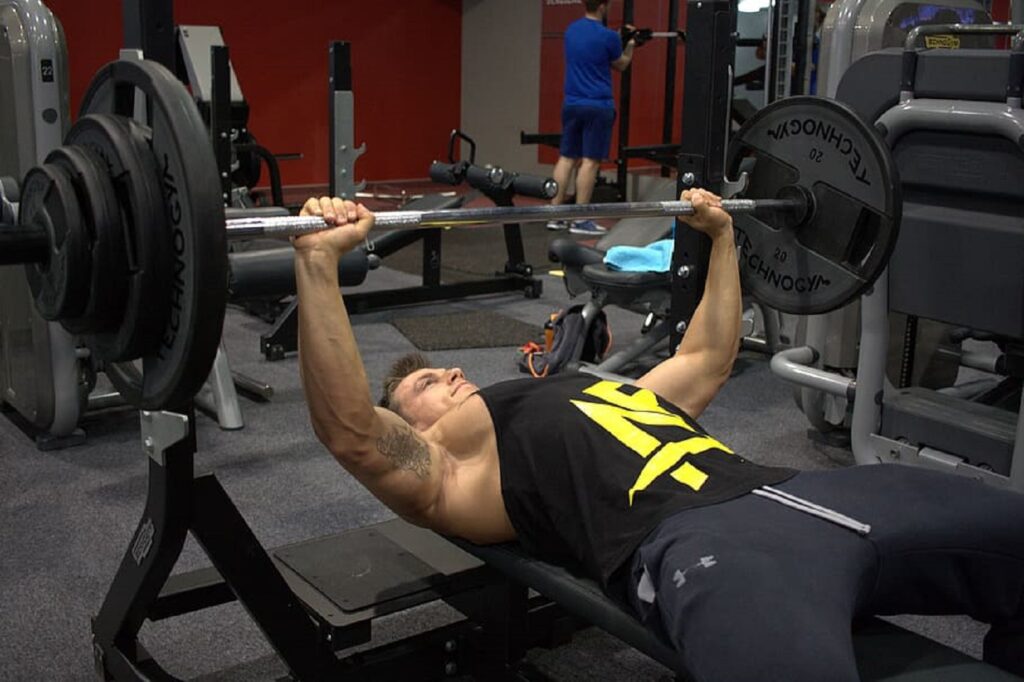German Volume Training has never gone out of style. It’s an old-school weight-training system that remains as popular as ever. Sometimes just called “10×10” or GVT, it prescribes 10 sets of 10 reps of one basic exercise per body part using relatively heavy weights. It sounds simple, but it is more complicated to do it effectively. Let’s explore the principles of German Volume Training, how it works, and how to best apply 10×10 to a bodybuilding routine.
GERMAN VOLUME TRAINING ORIGIN
American bodybuilder, gym owner, and trainer Vince Gironda advocated 10 sets of 10 reps per exercise for bodybuilders, perhaps as early as the 1950s. However, German Volume Training got its name in the 1970s, when it was popularized by Rolf Feser, coach of West Germany’s national weightlifting team. Thereafter, GVT was on twin tracks, as a bodybuilding system and an Olympic weightlifting system.
WHAT IS GERMAN VOLUME TRAINING?
These are the principles of German Volume Training when applied to bodybuilding.
One Exercise for 10 Sets of 10 Reps
This is the fundamental of German Volume Training. Choose one exercise per body part and perform it for 10 sets of 10 reps. This follows the law of specificity, popularized in the Bulgarian Method of weightlifting: Do one thing frequently to get better at it. It simplifies weight-training, allowing you to focus foremost on just one exercise per per body part and no more than two per workout. These exercises are always performed first in workouts for that reason. And 10 reps is in the sweet spot for both strength and muscle gains. Add a few supplemental exercises for three sets of 10 reps to work other areas of body parts, but the 10×10 exercises are always prioritized.
Compound Exercises
Whenever possible, the 10×10 exercises should be free-weight, compound exercises to work several muscles together with maximum weights. Examples include squats, deadlifts, bench presses, military presses, and barbell rows. Biceps and triceps can be worked 10×10 with isolation exercises, though you still prioritize free-weight, bilateral lifts, such as barbell curls and two-hand triceps extensions.

Maximum Weight
The goal of German Volume Training is to complete 10 sets of 10 repetitions for each prioritized exercise with maximum weights. If you fail to get 10 reps, lighten the weight slightly to get 10 on your next set(s). The goal is to stay at or near a maximum 10-rep weight for all 10 sets. To be sure, ten sets of the same exercise can grow tedious. Resist this, keep your intensity up, and aim for those 10 reps in set after set.
Progressive Overload
As you adapt to the 10 sets of 10 reps over subsequent workouts, it’s important to progressively increase the weight lifted. Don’t increase reps. Stay at 10 reps, but gradually increase the weight for exercises over time.
Short Rest Periods
Rest intervals between sets are kept in the 60-90 second range, so you will be moving, especially on taxing exercises like squats.
Low Training Frequency
Due to the high volume and intensity for each prioritized exercise, body parts are worked only once per week or once every six days. In our sample routine below, you can take two days off or rest one day before repeating the sequence.
THE SCIENCE OF GERMAN VOLUME TRAINING
A study published in the Journal of Strength and Conditioning Research found that high-volume training protocols, such as GVT, can lead to significant gains in muscle size and strength [1]. Another study published in the European Journal of Applied Physiology showed that high-volume training induces greater metabolic stress and muscle fiber recruitment, leading to enhanced muscle hypertrophy compared to lower volume training [2].

GERMAN VOLUME TRAINING PLAN
The follow 10×10 bodybuilding routine starts each workout with at least one prioritized exercise for 10 sets of 10 reps. Day 1 with squats (quads) and stiff-leg deadlifts (hamstrings) and Day 5 with barbell curls (biceps) and overhead triceps extensions (triceps) each have two 10×10 exercises.
We recommend performing GVT for a cycle of 4-6 weeks followed by at least 4-6 weeks of more conventional training before another GVT cycle. Doing so will keep the stress unique, curb the boredom of 10 sets of the same exercises, and allow for greater strength and hypertrophy gains.
DAY 1: THIGHS
Squat — 10 sets x 10 reps
Stiff-leg Deadlift — 10 sets x 10 reps
Leg Press — 3 sets x 10 reps
Leg Extension — 3 sets x 10 reps
Seated Leg Curl — 3 sets x 10 reps
Lunge — 3 sets x 10 reps
DAY 2: CHEST & ABS
Barbell Bench Press — 10 sets x 10 reps
Incline Dumbbell Press — 3 sets x 10 reps
Dip — 3 sets x 10 reps
Cable Crossover — 3 sets x 10 reps
Vertical Leg Raise — 3 sets x 10 reps
Machine Crunch — 3 sets x 10 reps
DAY 3: BACK & CALVES
Barbell Row — 10 sets x 10 reps
Pulldown — 3 sets x 10 reps
Seated Cable Row — 3 sets x 10 reps
Straight Arm Pulldown — 3 sets x 10 reps
Hyperextension — 3 sets x 10 reps
Standing Calf Raise — 3 sets x 10 reps
Seated Calf Raise — 3 sets x 10 reps
DAY 4: SHOULDERS
Military Press — 10 sets x 10 reps
Dumbbell Lateral Raise — 3 sets x 10 reps
Front Raise — 3 sets x 10 reps
Machine Rear Lateral — 3 x 10 reps
Dumbbell Shrug — 3 x 10 reps
Upright Row — 3 sets x 10 reps
DAY 5: ARMS
Overhead Triceps Extension — 10 sets x 10 reps
Barbell Curl — 10 sets x 10 reps
Pushdown — 3 sets x 10 reps
Seated Dumbbell Curl — 3 sets x 10 reps
Reverse Curl — 3 sets x 10 reps
Wrist Curl — 3 sets x 10 reps
GERMAN VOLUME TRAINING CONCLUSION
Everything old is new again. Whatever you call it, 10×10 has been around for over a half-century, and it’s never really gone away. That’s because it’s both a strength system and a bodybuilding program. It remains an effective way of targeting compound exercises for strength gains as well as stimulating multiple muscles for growth.
Resources
1. Radaelli, R., et al. (2015). “High-Volume Resistance Training Promotes Greater Increases in Muscle Size and Strength Compared to Low-Volume Resistance Training in Competitive Weightlifters.” Journal of Strength and Conditioning Research, 29(10), 2954-2964.
2. Schoenfeld, B.J., et al. (2019). “Effects of Resistance Training Volume on Hypertrophy: A Systematic Review and Meta-Analysis.” European Journal of Applied Physiology, 119(3), 1483-1498.
Related: Volume Training Guide
















































